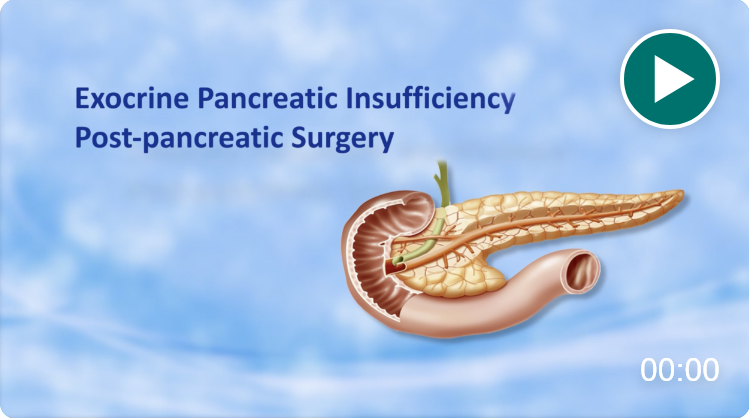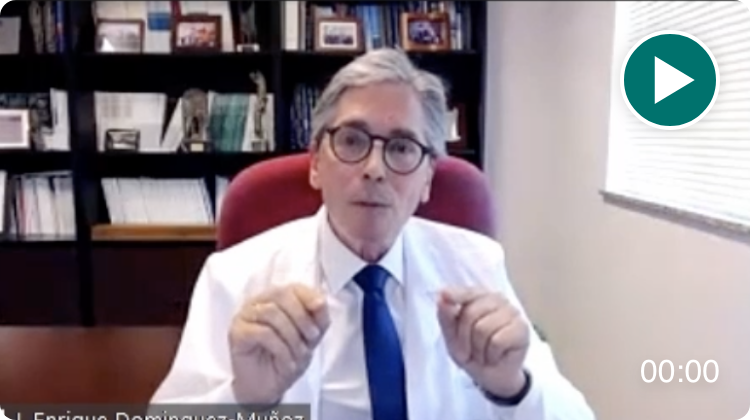
EPI Education
Take a deep dive into EPI and learn from experts in the field.
About EPI: EPI pathogenesis, symptoms, and diagnosis
Etiologies of EPI: Recognize EPI and the barriers to diagnosis
Management of EPI: Key information for managing EPI
Case Studies: Experts present case-based narratives on EPI
Select one or more filters below to explore topic-specific resources.
Transcript
Hello. I’m Dr. Allison Yang – I’m a board-certified gastroenterologist with a clinical focus in pancreatic diseases. I am discussing the case of a 40-year-old man with a history of recurrent acute pancreatitis presumed to be secondary to hypertriglyceridemia versus alcohol admitted with necrotizing pancreatitis. His past medical history is relevant for hypertension, hyperlipidemia, and recurrent acute pancreatitis. He’s on a number of medications including rosuvastatin, fenofibrate, omeprazole, sertraline, and gabapentin. The patient was managed conservatively with IV fluids and pain control. Initial CT scan showed acute necrotizing pancreatitis. The patient was readmitted 3 weeks later with increasing abdominal distention and decreased appetite. A follow-up CT showed rim enhancing fluid collections in the peritoneum and features consistent with walled off necrosis. We performed an EUS guided cyst gastrostomy and interventional radiology placed 4 drains. Fecal elastase was checked during hospitalization and was 109, consistent with a diagnosis of exocrine pancreatic insufficiency (or EPI). Let’s review the etiology and risk factors of EPI in patients with acute pancreatitis. Acute pancreatitis is an inflammatory process of the pancreas. The exocrine pancreas comprises approximately 90% of the pancreatic mass. Acinar cells within the exocrine pancreas are responsible for the synthesis and secretion of digestive enzymes required for nutrient digestion in the intestine. Acute pancreatitis occurs when trypsinogen is prematurely activated into its active digestive form, trypsin, within acinar cells. This is most commonly triggered by gallstones, alcohol abuse, or hypertriglyceridemia. The premature activation of large amounts of trypsin within the pancreas leads to the activation of several other enzymes leading to autodigestion of the gland, acinar cell necrosis, and the leakage of digestive enzymes into the surrounding pancreatic tissue and peripancreatic space. This triggers local immune cells to secrete inflammatory mediators leading to inflammation and further acinar cell necrosis. When the production, delivery or activity of digestive enzymes is impaired during exocrine pancreatic insufficiency, or EPI, steatorrhea and weight loss can occur. The destruction of pancreatic tissue during acute pancreatitis is an important cause of EPI and can lead to insufficient digestion of food. Patients with acute pancreatitis should therefore be monitored closely by HCPs for symptoms of EPI. Studies show the pooled prevalence of EPI after an initial episode of acute pancreatitis ranges from 27-35%. The risk of EPI is highest in patients with moderately severe and severe acute pancreatitis, those with necrosis and especially if they require necrosectomy, recurrent acute pancreatitis, and alcohol etiology of pancreatitis. Studies show that recovery from EPI may take many months. After 5 years, recovery may still remain incomplete in more than one third of affected patients, including up to 20% of those who had mild acute pancreatitis. Consider checking fecal elastase in the hospital before discharge and at follow-up visits to evaluate for EPI.
Announcer: This program was sponsored by AbbVie US Medical Affairs. If you missed any part of this discussion, visit ReachMD.com/IndustryFeature. This is ReachMD. Be part of the knowledge.

Many Faces of EPI - Acute Pancreatitis
Review a patient case study and the risk factors of EPI in patients with acute pancreatitis.

Take an immersive journey into the physiology of the exocrine pancreas and the pathophysiology of EPI.

















